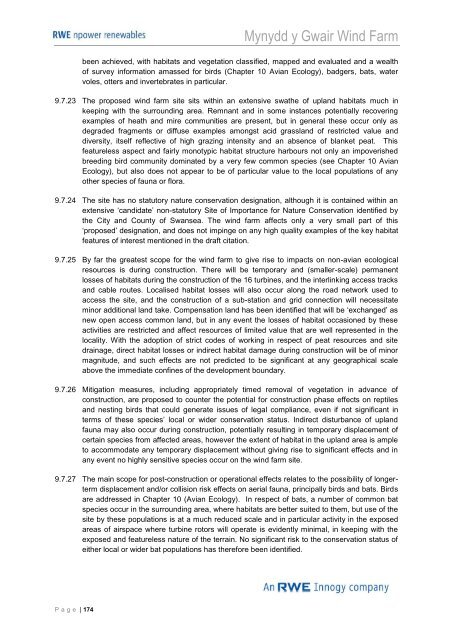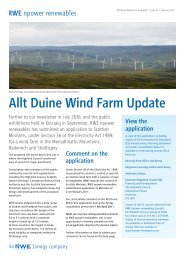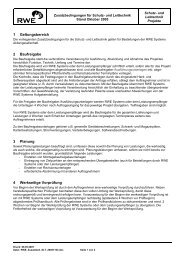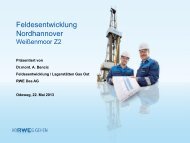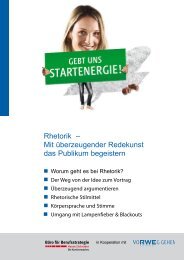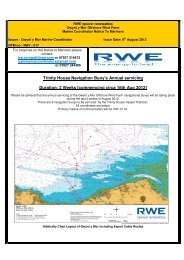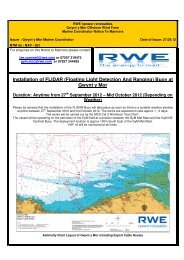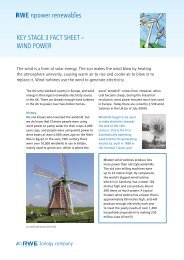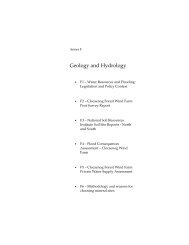Mynydd y Gwair Wind Farm - RWE.com
Mynydd y Gwair Wind Farm - RWE.com
Mynydd y Gwair Wind Farm - RWE.com
You also want an ePaper? Increase the reach of your titles
YUMPU automatically turns print PDFs into web optimized ePapers that Google loves.
P a g e | 174<br />
<strong>Mynydd</strong> y <strong>Gwair</strong> <strong>Wind</strong> <strong>Farm</strong><br />
been achieved, with habitats and vegetation classified, mapped and evaluated and a wealth<br />
of survey information amassed for birds (Chapter 10 Avian Ecology), badgers, bats, water<br />
voles, otters and invertebrates in particular.<br />
9.7.23 The proposed wind farm site sits within an extensive swathe of upland habitats much in<br />
keeping with the surrounding area. Remnant and in some instances potentially recovering<br />
examples of heath and mire <strong>com</strong>munities are present, but in general these occur only as<br />
degraded fragments or diffuse examples amongst acid grassland of restricted value and<br />
diversity, itself reflective of high grazing intensity and an absence of blanket peat. This<br />
featureless aspect and fairly monotypic habitat structure harbours not only an impoverished<br />
breeding bird <strong>com</strong>munity dominated by a very few <strong>com</strong>mon species (see Chapter 10 Avian<br />
Ecology), but also does not appear to be of particular value to the local populations of any<br />
other species of fauna or flora.<br />
9.7.24 The site has no statutory nature conservation designation, although it is contained within an<br />
extensive „candidate‟ non-statutory Site of Importance for Nature Conservation identified by<br />
the City and County of Swansea. The wind farm affects only a very small part of this<br />
„proposed‟ designation, and does not impinge on any high quality examples of the key habitat<br />
features of interest mentioned in the draft citation.<br />
9.7.25 By far the greatest scope for the wind farm to give rise to impacts on non-avian ecological<br />
resources is during construction. There will be temporary and (smaller-scale) permanent<br />
losses of habitats during the construction of the 16 turbines, and the interlinking access tracks<br />
and cable routes. Localised habitat losses will also occur along the road network used to<br />
access the site, and the construction of a sub-station and grid connection will necessitate<br />
minor additional land take. Compensation land has been identified that will be „exchanged‟ as<br />
new open access <strong>com</strong>mon land, but in any event the losses of habitat occasioned by these<br />
activities are restricted and affect resources of limited value that are well represented in the<br />
locality. With the adoption of strict codes of working in respect of peat resources and site<br />
drainage, direct habitat losses or indirect habitat damage during construction will be of minor<br />
magnitude, and such effects are not predicted to be significant at any geographical scale<br />
above the immediate confines of the development boundary.<br />
9.7.26 Mitigation measures, including appropriately timed removal of vegetation in advance of<br />
construction, are proposed to counter the potential for construction phase effects on reptiles<br />
and nesting birds that could generate issues of legal <strong>com</strong>pliance, even if not significant in<br />
terms of these species‟ local or wider conservation status. Indirect disturbance of upland<br />
fauna may also occur during construction, potentially resulting in temporary displacement of<br />
certain species from affected areas, however the extent of habitat in the upland area is ample<br />
to ac<strong>com</strong>modate any temporary displacement without giving rise to significant effects and in<br />
any event no highly sensitive species occur on the wind farm site.<br />
9.7.27 The main scope for post-construction or operational effects relates to the possibility of longerterm<br />
displacement and/or collision risk effects on aerial fauna, principally birds and bats. Birds<br />
are addressed in Chapter 10 (Avian Ecology). In respect of bats, a number of <strong>com</strong>mon bat<br />
species occur in the surrounding area, where habitats are better suited to them, but use of the<br />
site by these populations is at a much reduced scale and in particular activity in the exposed<br />
areas of airspace where turbine rotors will operate is evidently minimal, in keeping with the<br />
exposed and featureless nature of the terrain. No significant risk to the conservation status of<br />
either local or wider bat populations has therefore been identified.


